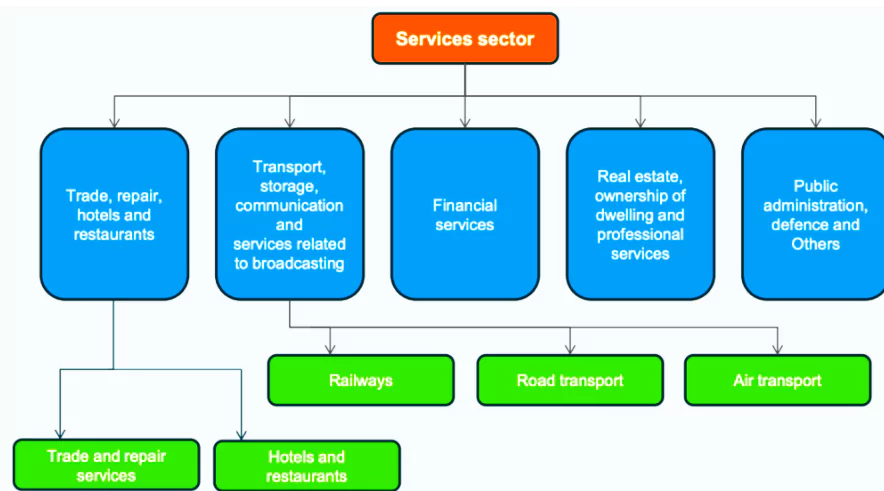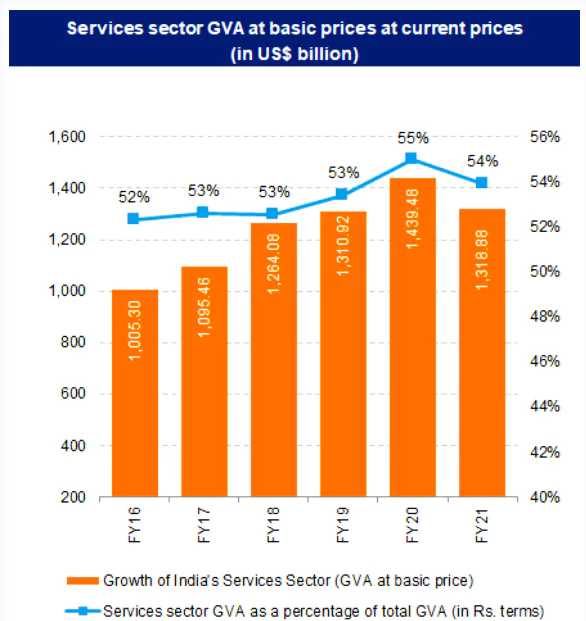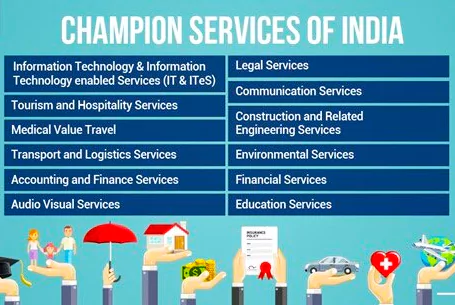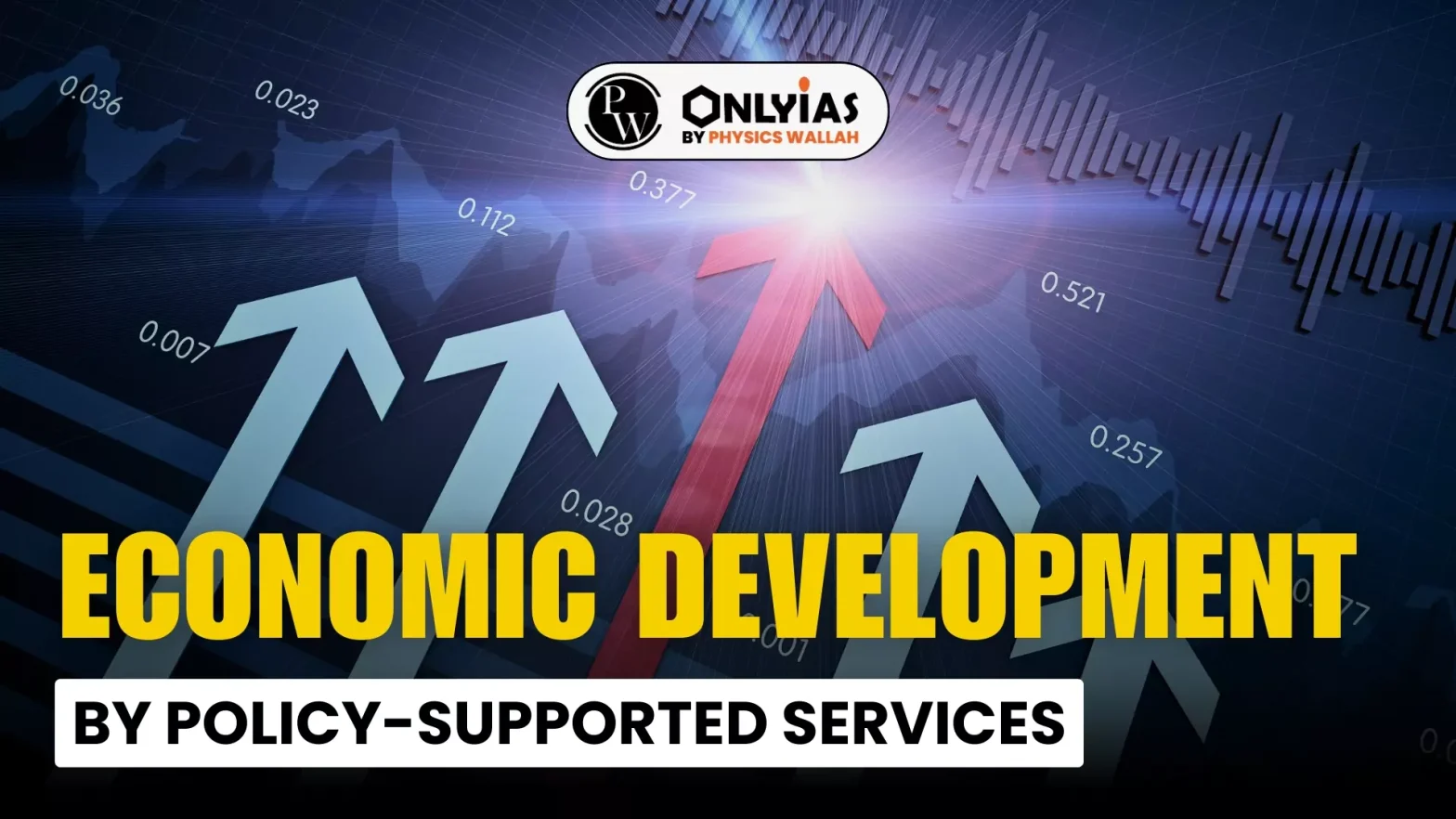Manufacturing-led development has been the traditional model for creating jobs and prosperity. But in the past few decades, the services sector has grown faster than the manufacturing sector in many developing economies.
- As per the World Economic Forum’s Future of Jobs Report 2020, by 2025, 85 million jobs may be displaced by automation, but 97 million new roles, primarily in emerging professions such as data analysis and artificial intelligence, may be created.
About Economic Development
Economic development has a lasting impact on citizens. Increased economic growth means more revenue for the government, which can be used for public services and infrastructure development.
- Refers: Economic Development is programs, policies or activities that seek to improve the economic well-being and quality of life for the citizens.
- Economic Development Strategies: Though economic development priorities vary, economic development strategies often aim for common, positive results, such as:
- Creating more jobs and more job variety
- Keeping businesses and getting new ones
- A better quality of life
- Making and selling more local products
Enroll now for UPSC Online Course
Manufacturing Sector in India
Manufacturing is an integral and huge part of the economy. It involves processing and refining raw materials, such as ore, wood, and foodstuffs, into finished products, such as metal goods, furniture, and processed foods. Converting these raw materials into something more useful adds value.
- Contribution: The manufacturing sector in India contributes 16-17% of GDP.
- It employs over 27.3 million workers.
- India is the third most sought-after manufacturing destination in the world and has the potential to export goods worth US$ 1 trillion by 2030.
- Achievement: Manufacturing exports have registered the highest ever annual exports of US$ 447.46 billion with 6.03% growth during FY23 surpassing the previous year (FY22) record exports of US$ 422 billion.
- By 2030, the Indian middle class is expected to have the second-largest share in global consumption at 17%.
- Target: India aims to increase the manufacturing sector’s contribution to 25% of the economy’s output by 2025 as per the goal of Make in India through the execution of several programmes and policies.
Challenges Faced by Developing Countries in Manufacturing Sector
The manufacturing sector is regarded as the backbone of both social and economic development. However, facing various following issues:
- Rise in Automation: Innovation in manufacturing has taken a predominantly skill-biased form, reducing demand for workers with relatively low levels of education.
- New technologies such as automation, robots and 3D printing directly substitute physical capital for labour.
- Evolving Skill Demands:
- As automation permeates manufacturing processes, the skills demanded of manufacturing workers is evolving. Jobs that require manual labour and repetitive tasks are declining.
- Global Quality Competition: Firms in developing countries need to produce according to the exacting quality standards set by global value chains that impacts unskilled labour and can easily be substituted for physical capital and skilled labour.
- While firms in developing countries have an incentive to use more labour-intensive techniques, competing in the global marketplace requires employing production techniques that cannot differ significantly from those used in the frontier economies.
- Limited Growth: The rising skill- and capital-intensity of manufacturing means that formal segments of manufacturing in developing countries have lost the ability to absorb significant amounts of labour.
- They have effectively become ‘enclave sectors,’ not too different from mining, with limited growth potential and few positive effects on the supply side of the rest of the economy.
Need to Focus on Policy-Supported Services Sector
Service sector is crucial because it contributes significantly to the country’s economic growth and GDP and with the current scenario, a policy-supported services sector is a need of the hour.
- Reason: Enhancing productivity in labour-absorbing services has become an essential priority, for reasons of both growth and equity. Since the bulk of jobs will be in services, these jobs need to be productive enough to support income growth.
- Action Followed: There is already a foundation of practice on what might be called “industrial policies for services” on which future efforts can build.
- Challenges: The conundrum is that it is not known much about how to raise productivity in labour- absorbing services.
- While some services, such as banking, infotech and business-process outsourcing (BPO) are both productively dynamic and tradable, they will not be labour-absorbing for the same reason (skill-intensive services) that manufacturing is not.
- The challenge is to increase productivity in labour-absorbing services such as retail, care and personal and public services, which has had limited success, in part because such services have never been an explicit target of productive development policies.
Check Out UPSC CSE Books From PW Store
Service Sector in India
The service sector provides a wide range of services, from healthcare to finance, which adds value to people’s lives and contributes to the overall wealth of the nation.

- Refers: The service sector is also known as the tertiary sector.
- It is one of the three sectors of the economy, the other two being the primary sector (includes agriculture, forestry, mining, and fishing) and the secondary sector (includes manufacturing and construction).
- Includes: India’s services sector covers a wide variety of activities such as trade, hotel and restaurants, transport, storage and communication, financing, insurance, real estate, business services, community, social and personal services, and services associated with construction.
- Evolution & Development: The reforms of the 1990s have been associated with the expansion of the service sector in India.
- Midway through the 1980s, the service sector began to expand, but it took off in the 1990s when India started a series of economic reforms in response to a serious balance of payments issue.
- Jurisdiction:
- Union List: Telecommunications, postal, broadcasting, financial services (including insurance and banking), national highways, mining services.
- State List: Healthcare and related services, real estate services, retail, services incidental to agriculture, hunting, and forestry.
- Concurrent List: Professional services, education, printing and publishing, electricity.
- Contribution: The service sector has over 50% contribution to India’s GDP.
- The service sector has emerged as the highest employment generator with a 5-7% y-o-y growth in 2022.
 The share of the services sector accounted for 57% of the total Gross Value Added (GVA) in FY24 (April-September) as per advance estimates.
The share of the services sector accounted for 57% of the total Gross Value Added (GVA) in FY24 (April-September) as per advance estimates. - As per data released by the Department for Promotion of Industry and Internal Trade (DPIIT), the services category ranked first in FDI inflows.
- India’s service exports stood at US$ 163.94 billion, whereas imports stood at US$ 88.89 billion in (April-September) 2023-24. The services trade surplus for 2023-24 (April-September) is expected to be US$ 75.05 billion.
- Future Prospects:
- Upcoming sectors are expected to contribute to rapid expansion of services sector in India:
- By 2025, the healthcare industry is expected to reach US$ 372 billion.
- By 2025, India’s digital economy is estimated to reach US$ 1 trillion.
- By the end of 2023, India’s IT and business services sector is expected to reach US$ 14.3 billion with 8% growth.
- By 2035, Artificial Intelligence (AI) is expected to boost India’s annual growth rate by 1.3% .
Initiatives taken by the India to Promote Service Sector Growth
To achieve growth in the service sector, following initiatives has been taken by India:

- Action Plan for Champion Sectors in Services: To give focused attention to 12 identified Champion Services Sectors.
- Pradhan Mantri Jan Dhan Yojana (PMJDY): As of November 9, 2022, the number of bank accounts opened under PMJDY scheme reached 47.39 crore and deposits in Jan Dhan bank accounts totalled Rs. 1.76 lakh crore (US$ 21.59 billion).
- Production-linked Incentive (PLI) Scheme: In October 2021, the government launched a PLI scheme to boost manufacturing of telecom and networking products in India.
- Mahatma Gandhi National Fellowship (MGNF): In October 2021, the government launched phase II of MGNF to empower students and boost skill development.
- PM Ayushman Bharat Health Infrastructure Mission: It was launched in October 2021 to strengthen the critical healthcare network across India in the next four to five years.
- 100% FDI: The FDI limit for insurance companies has been raised from 49% to 74% and 100% for insurance intermediates.
- Third phase of Pradhan Mantri Kaushal Vikas Yojana (PMKVY): It was launched in January, 2021 tol focus on new-age and COVID-related skills.
- National Digital Health Mission (NDHM): It was launched in 2020 to provide a unique health ID to every Indian and revolutionize the healthcare industry by making it easily accessible to everyone in the country.
- Over the next 10 years, the National Digital Health Blueprint can unlock the incremental economic value of over US$ 200 billion for the healthcare industry in India.
- National Broadband Mission: The government of India has launched the National Broadband Mission to provide Broadband access to all villages by 2022.
- IGnITE Programme: It was launched in December 2020 to encourage high-quality training and technical education.
- ‘IGnITE’ aims to develop highly trained technicians based on the German Dual Vocational Educational Training (DVET) model. By 2024, this programme aims to upskill about 40,000 employees.
- Germany’s dual vocational education and training system is highly regarded worldwide for its emphasis on practical training and close collaboration between industry and educational institutions.
- To enhance India’s commercial services exports, share in the global services market from 3.3% and permit a multi-fold expansion in the GDP, the government is also making significant efforts in this direction.
- PM Gati Shakti: National Master Plan for multimodal connectivity infrastructure project.
- Bharatmala Project: To Improve connectivity in North East India.
- Start-up India: To catalyse Startup culture in India.
Enroll now for UPSC Online Classes
Way Forward
Four strategies for expanding productive employment in services that create the most jobs in developing countries are as follows:
- Focus on Large and Productive Firms:
- Incentivize Expansion: Encourage large, productive firms to expand employment directly or through local supply chains.
- Target Firms: Include large retailers, platforms such as ride-sharing services, or even manufacturing exporters (with potential to generate upstream linkages with service providers).
- Focus on Small Enterprises:
- Enhance Capabilities: The next strategy requires to focus on small enterprises (which constitute the bulk of firms in most developing countries) and aims to enhance their productive capabilities through the provision of specific public inputs.
- These inputs could be management training, loans or grants, customised worker skills, specific infrastructure or technology assistance.
- Need-based Policy Approach: Given the heterogeneity of such firms, ranging from micro-enterprises and self-owned proprietorships to midsize companies, policies in this domain require a differentiated approach that responds to their distinct needs.
- Moreover, given the numbers involved, policies often also require a suitable mechanism for selecting among the most promising firms, since most are unlikely to become dynamic and successful.
- Focus on the Provision of Digital Tools and New Technologies:
- Compliment low-skilled labour: There is a need to focus on the provision, to workers directly or to firms, of digital tools or other forms of new technologies that explicitly complement low-skill labour.
- Expand Task Range: It is to enable less educated workers to do (some of) the jobs traditionally reserved for more skilled professionals and to increase the range of tasks they can perform.
- Reshaping of Human Resources:
- Vocational Training: This strategy also focuses on less-educated workers and combines vocational training with ‘wrap-around’ services, a range of additional assistance programmes for job seekers to enhance their employability, retention and eventual promotion.
- Employer Collaboration: Modelled after Project Quest, a US-based initiative, and other similar sectoral workforce development schemes, these training programmes typically work closely with employers, both to understand their needs and to reshape their human-resource practices to maximise employment potential.
Conclusion
With the rise in automation in the manufacturing landscape, while job displacement is a serious concern, the real success in a services-oriented development strategy will require greater ambition, continuous experimentation and the implementation of a very wide range of programmes.
India’s march towards a $5 trillion economy by 2025 and role of Service Sector
- India is one of the fastest growing major economies and its strengths are indicative of the potential of India to achieve a USD 5 trillion economy by 2025.
- The current structure of the economy and the emerging dynamics provide us grounds to target achieving 1 trillion dollars from agriculture and allied activities, 1 trillion from manufacturing and 3 trillion from services.
|
![]() 26 Jun 2024
26 Jun 2024


 The share of the services sector accounted for 57% of the total Gross Value Added (GVA) in FY24 (April-September) as per advance estimates.
The share of the services sector accounted for 57% of the total Gross Value Added (GVA) in FY24 (April-September) as per advance estimates. 